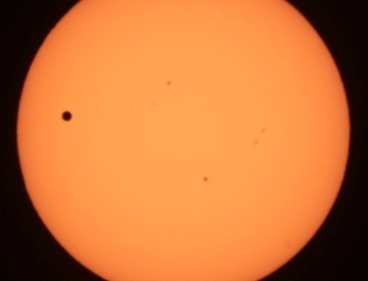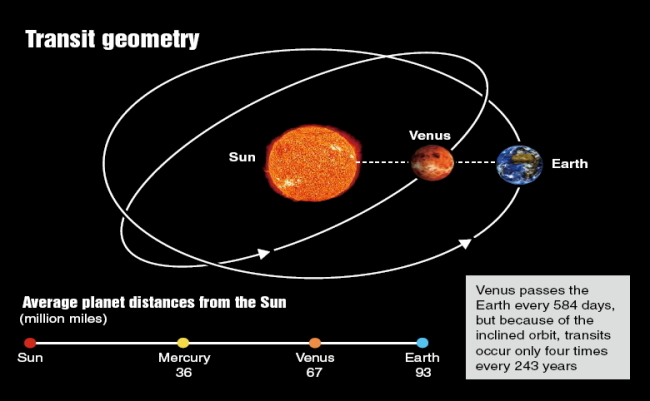
The last Venus transit of this century to take place June 6
People whose birthday is on June 6 should expect a special gift from mother nature. On this day a rare astronomical event will unfold, visible from most parts of the Asia-Pacific region, including the Korean Peninsula.
From the early morning hours’ planet Venus will move across Sun, an event lasting for 6-7 hours until the early afternoon. The 2012 transit of Venus will be the last one visible from Earth in this century with the next transits in the years 2117 and 2125.
Scientific significance
Planet Venus was known by many ancient civilizations. It is most often recognized and referred to as a “morning star” or an “evening star,” depending on its position in its orbit relative to Earth. Venus ― the second planet from the Sun ― is named after the Roman goddess of love and beauty. Though its name sounds romantic, Venus is a very hostile place with surface temperatures ranging from some freezing -200 degrees C to a roasting 400 C. Its atmospheric composition is mostly carbon dioxide.
Astronomical planetary transits as observed from Earth are one of the rare natural phenomena in the universe. This year’s transit of Venus is the second of a pair of transits. The two transits are eight years apart from each other and the last crossing of Venus over the disk of the Sun occurred in June 2004.
A Venus transit occurs when the Sun, Venus and Earth co-align with each other. The event is rare due to the orbital inclination of Venus relative to Earth’s orbit. Transits of other planetary bodies occur as well. Because of its lower orbital inclination, transits by Mercury (the first planet from the Sun) occur much more frequently. The next Mercury transit will take place in 2016.
The possibility of a Venus transit as observed from Earth was first predicted by Johannes Kepler (1571-1630), known for the famous three laws of planetary motion. Using his understanding of the movements of the planets, Kepler was able to predict Venus transiting in the years 1631 and 1761.
At almost the same time, British astronomer Jeremiah Horrocks (1618-1641) refined some of Kepler’s calculations and predicted the transit in the year 1639 (which Kepler missed). Together with his contemporary friend William Crabtree (1610-1644) they were the first humans to record a Venus transit by safely projecting the Sun on a piece of paper with the use of glass lenses.
Observing a Venus transit has great scientific importance. Recording the motion of Venus from two different geographical locations allows us to measure the distance between the Earth and the Sun. In the 17th century only relative distances between the planets were known. Using the transit measurements from 1639 enabled Horrocks to determine a relatively accurate Sun-Earth distance.
More accurate observations leading to ever more refined Sun-Earth distance measurements were carried out in the years 1761/1769 and 1874/1882. In these years Venus transit events were predicted to occur, and accordingly, scientific voyages planned to different corners of the world.

One particular journey was carried out by Captain James Cook (1728-1779) a British explorer and navigator. Cook’s first voyage took him to Tahiti in the Pacific ocean from where he observed the 1769 transit. To their great disappointment the quality of the recorded data was not satisfactory in order to arrive at a reliable distance measurement.
However, subsequent observations of the Venus passage resulted in a fairly accurate determination of the Sun-Earth distance. In today’s space-age this distance is measured to within a few tenths of a meter using space-based, radio-communication technology. However, video-recording a Venus transit will provide an excellent opportunity to communicate astronomy and related science to young pupils and students.
Public viewing
Weather permitting, the June 6 Venus transit will be observable from everywhere on the Korean Peninsula. Refer to the fact box for additional information. For a successful experience, special viewing equipment is necessary such as special solar eclipse glasses or projection telescopes. However, it is strongly advised that one should never look directly into the Sun as this may result in blindness.
Most public planetariums, observatories, schools and higher research institutions and universities may arrange a safe public “Transit of Venus” viewing or outreach program with professional staff providing additional information. Local planetariums may even provide solar eclipse glasses at low costs. In addition, in case of cloudy weather, the event can be watched from various Internet portals providing a live video stream of the event. The famous Keck Observatory on the Hawaiian Island in the Pacific will offer this service for the general public and is free of charge.
However, to ensure a good local view of Venus in front of the Sun, place yourself in an open area like a mountain top. On June 6, at around 6:55 a.m. Korean standard time, the Sun will be easily located and sitting toward the east at an elevation of about 20 degrees (about two hand widths) above the local horizon.
By Tobias Cornelius Hinse
Dr. Tobias Cornelius Hinse is an astrophysicist at the Korea Astronomy & Space Science Institute in Daejeon. He is currently holding a KRCF Young Scientist Research Fellowship and carries out astronomical research on planetary science and extrasolar planets. He graduated from the Niels Bohr Institute at the University of Copenhagen in Denmark and received his Ph.D. from the Armagh Observatory/Queens University Belfast, U.K. ― Ed.
Venus transit details on June 6 (Times in KST)
Location: Daejeon, 36 degrees 21” 01’.5 N, 127o 23” 04’.4 E
Time of sunrise: 05:17:15
Time of sunset: 19:43:54
Time of 1st contact (ingress, exterior): 07:10:42
Time of 2nd contact (ingress, interior): 07:28:20
Time of closest approach: 10:30:18
Time of 3rd contact (egress, interior): 13:30:59
Time of 4th contact (egress, exterior): 13:48:23
The first time of contact (ingress, exterior) marks the beginning of the transit event. At that time Venus is just outside the solar disc. From this time and onward, Venus will be clearly discernible and visible as a black dot. The fourth time of contact marks the end of the event.
Note: The times are for an observer located in Daejeon. To obtain precise transit details for a different location, please consult the following website: http://transitofvenus.nl/wp/where-when/local-transit-times
<관련 한글 기사>
놓쳤으면 이제 105년간 못 볼 '금성일식'!
금성이 태양을 가로지르는 우주쇼가 6일 오전 7 시 9분 38초부터 시작돼 오후 1시 49분 35초까지 약 6시간 40분간 우리나라 전역에서 펼쳐졌다.
금성의 태양면 통과를 이번에 놓치면 2117년 12월 10일, 2125년 12월 8일에나 볼 수 있다. 우리 세대에서는 사실상 마지막 관측인 셈이다.
금성은 태양보다 32분의 1정도로 작아, 까만 점이 태양의 밝은 면을 천천히 지나는 모습으로 나타났다. 이번 통과는 금성이 태양의 왼쪽 상단부터 오른쪽 상단을 향해 대각선으로 비스듬히 내려가듯 진행됐다.
금성의 태양면 통과 현상은 지구-금성-태양이 일직선상에 놓이고, 지구의 공전 궤도와 금성의 공전궤도 간에 교차점이 생길 때만 발생한다. 지구-금성-태양이 일렬 로 늘어서는 1.6년마다가 아닌, 8년-105.5년-8년-121.5년 주기를 갖는 이유다.
지구에서 태양면 통과 현상이 관측되는 행성은 금성과 수성 뿐이다.
수성의 태양면 통과는 1631년 프랑스의 천문학자 피에르 가센디가 최초로 관측했다. 가센디는 한달 뒤 금성의 태양면 통과를 관측할 기회가 있었으나 프랑스 지역 에선 이 현상이 태양이 뜨기 50분 전에 끝나 실패했다.
금성의 태양면 통과를 처음 관측한 영광은 1639년 영국의 아마추어 천문학자 제레니 호럭과 그의 친구 윌리엄 크랩트리에게 돌아갔다.
미국의 작곡가 존 필립 소사는 1882년 이 우주 현상을 기념하기 위해 '금성의 태양면 통과 행진곡(Transit of Venus March)'이란 관악곡을 썼다. 그는 미국 국 인 '성조기여 영원하라'도 작곡했다.
이번 통과 현상은 태양을 잘 볼 수 있는 트인 공간 어디에서라도 볼 수 있었다. 맨눈으로 직접 보면 실명할 수 있으므로 태양필터, 용접용 유리 등의 보호장비가 필 요한 만큼 많은 관측자들이 전국 각지에서 열리는 행사장을 찾았다.
자세한 정보는 한국천문연구원 홈페이지(www.kasi.re.kr)에서 확인할 수 있으며, 시간별로 촬영한 관측 사진을 공개했다.
-
Articles by Korea Herald







![[KH Explains] Hyundai's full hybrid edge to pay off amid slow transition to pure EVs](http://res.heraldm.com/phpwas/restmb_idxmake.php?idx=644&simg=/content/image/2024/04/18/20240418050645_0.jpg&u=20240419100350)







![[From the Scene] Monks, Buddhists hail return of remains of Buddhas](http://res.heraldm.com/phpwas/restmb_idxmake.php?idx=652&simg=/content/image/2024/04/19/20240419050617_0.jpg&u=20240419175937)

![[KH Explains] Hyundai's full hybrid edge to pay off amid slow transition to pure EVs](http://res.heraldm.com/phpwas/restmb_idxmake.php?idx=652&simg=/content/image/2024/04/18/20240418050645_0.jpg&u=20240419100350)

![[Today’s K-pop] Illit drops debut single remix](http://res.heraldm.com/phpwas/restmb_idxmake.php?idx=642&simg=/content/image/2024/04/19/20240419050612_0.jpg&u=)